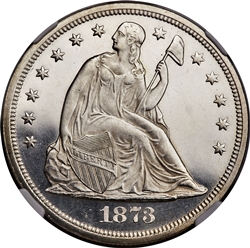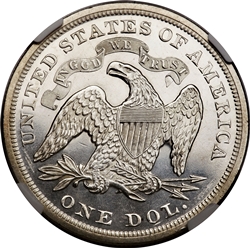 |
1873
 

|
 |
General Comments
In the final year of Liberty Seated dollar coinage, the mintage receded from the high point reached in 1872,
though it was still large by Seated dollar standards. This date is often lumped together with 1871 and 1872
and considered common. It’s not rare, but it is tougher to find than its two younger sisters. Examples of
the date are readily available. There is, however, an additional demand on the available supply, since many
collectors like to add the first and/or last year of issue to their type sets. Because of this 1873 coins
bring a slight premium over other common dates.
|
| |||||||||||||||||||||
1873 examples exhibit major strike variations. We’ve seen fully struck examples, but we’ve also seen coins with major strike weakness. Our die marriages OC-4 and OC-4a seem particularly susceptible to strike weakness, often seen with right side stars that are very flat and additional weakness on the upper left-wing edge. Two MS65 examples auctioned since 2015 have shown major weakness on the right-side stars. However, well-struck examples can be found with patient searching.
High-grade business strikes are sometimes prooflike or semi-prooflike, but more often frosty. With a mintage of nearly 300,000 coins spread over only three obverse dies and two reverses the dies wore sufficiently to eliminate prooflike surfaces for most examples. But those who love prooflike surfaces can find examples with patient searching.
It should be noted that our research indicates that a new obverse hub or master die was introduced in 1873 and used to produce the proof obverse die, Obverse P1, and at least two business strike obverses, Obverse 1 and Obverse 2. Numerous lumps that appear on Miss Liberty’s neck and are diagnostic of Obverse P1, the proof obverse die (see the description for OC-P1) have also been noted on Obverse 1 and Obverse 2, indicating that they came from the hub, or the master die. These are not seen on any earlier obverse dies, nor on Obverse 3.
1873 Die Marriages
Seven die marriages have been positively identified. 3 obverse dies were paired with 2 reverses to strike six business strike die pairs. These include 2 re-marriages. All business strike reverse dies were new, with none transitioned from 1872. None of the business strike dies were used for proofs. A single proof die marriage is known, pairing two unique dies. The reverse die is transitional, first used in 1872. The following table summarizes the known 1873 die marriages.
Click the links below to view the details of each die marriage.
Die Marriage |
Rarity |
Obverse Die |
Reverse Die |
Estimated Survivors |
| OC-1 | R4- | 1 | A | 190 |
| OC-2 | R2 | 1 | B | 690 |
| OC-2a | R4- | 1 | B | 200 |
| OC-3 | R6 | 2 | B | 20 |
| OC-4 | R4+ | 3 | B | 110 |
| OC-4a | R3+ | 3 | B | 290 |
| OC-P1 | R3 | P1 | 1872 PA | 360 |
The OC-3 die marriage is notably rare. We’ve confirmed only 2 examples, both noted in the Heritage archives. Heritage hasn’t sold an example since the 2014 Summer Long Beach sale.
1873 Business Strike Emission Sequence
The 1873 emission sequence is well-determined, although there is some uncertainty in the relative positions of
OC-2 vs. OC-4 as well as OC-2a vs. OC-4a. The differences in the states of Reverse B that define these marriages
are very minor and open to interpretation. Suffice it to say we made our best educated guess.
Emission Order |
Die Marriage |
Comments |
| 1 | OC-1 | |
| 2 | OC-2 | Obverse 1 die polish significantly reduced the unfinished area under the chin, placing OC-2 after OC-1 |
| 3 | OC-4 | Reverse B die polish indicates that OC-4 came after OC-2, but the differences are minor and open to interpretation. |
| 4 | OC-3 | Reverse B die polish reduced the relief of the end of the scroll under UST, placing OC-3 after OC-4 |
| 5 | OC-2a | Reverse B die polish indicates that OC-2a came after OC-3 |
| 6 | OC-4a | Reverse B die polish indicates that OC-4 came after OC-2a, but the differences are extremely minor and open to interpretation |
1873 Proof Emission Sequence
With only a single proof die marriage identified the emission sequence is simple.
Emission Order |
Die Marriage |
Comments |
| 1 | OC-P1 |
1873 Quick Finder Chart
All dies have notable markers. However, the date positions are similar, so care should be taken in
making attributions. First identify the reverse die, then determine the date position. The
following table shows the best markers to allow quick attribution.
Die Marriage |
Obv Die |
Rev Die |
Right |
1st 1 |
Keys |
| OC-1 | 1 | A | LE | SH | Obverse: High date. Right base of over LE. Lump on neck below Miss Liberty's chin (from the master d ie). Reverse: Tiny die lumps around E in WE. A die line slants down to the left connecting the lower right side of the G in GOD to the edge of the scroll. |
| OC-2 | 1 | B | LE | SH | Obverse: High date. Right base of over LE. Lump on neck below Miss Liberty's chin (from the master die). Reverse: Several lumps right and just above the serif of G in GOD. The right end of the scroll is fully defined. |
| OC-2a | 1 | B | LE | SH | Obverse: High date. Right base of over LE. Lump on neck below Miss Liberty's chin (from the master die). Reverse: Several lumps right and just above the serif of G in GOD. The right end of the scroll has been weakened by die polishing. |
| OC-3 | 2 | B | JR of C | SH | Obverse: High date. Right base of 1 is JR of C. Grid = 4-5.0, farthest left date in 1873. Reverse: Several lumps right and just above the serif of G in GOD. The right end of the scroll may be either fully defined or slightly weak. |
| OC-4 | 3 | B | RE | C | Obverse: 1 is centered vertically, 3 is slightly low. Lumps in 7th shield recess above Y in LIBERTY. Reverse: Several lumps right and just above the serif of G in GOD. The right end of the scroll is fully defined. |
| OC-4a | 3 | B | RE | C | Obverse: 1 is centered vertically, 3 is slightly low. Lumps in 7th shield recess above Y in LIBERTY. Reverse: Several lumps right and just above the serif of G in GOD. The right end of the scroll has been weakened by die polishing. |
| OC-P1 | P1 | 1872 PA | RE | C | Obverse: Numerous lumps on Miss Liberty's neck and breast (from the master die). Reverse: Strongly doubled reverse die. |
| Photo credits:
Obverse and reverse full photos: 1873 NGC PR66 Ultra Cameo, from the Heritage archives. |
